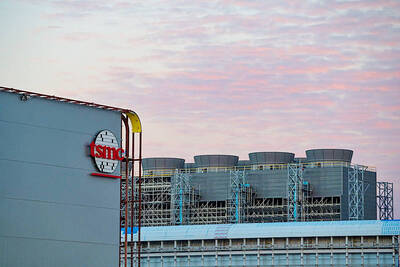US stock markets took another pounding on Friday as nervous investors braced for fresh volatility next week amid increased fears about the vast US mortgage market and a growing credit crunch.
The Dow Jones Industrial Average took a heavy beating on Friday, plunging more than 200 points from a day earlier, as the mortgage and credit concerns continued to eat away at investor confidence.
Some analysts said that the US Federal Reserve may refer to the market volatility in a statement it will issue after its interest rate meeting next Tuesday, but most economists expect the US central bank to keep its short-term fed funds rate pegged firm at 5.25 percent.

PHOTO: AP
The blue-chip Dow lost 0.63 percent for the week to end Friday at 13,181.91, following on the back of a much steeper decline of over four percent in the prior week.
The Standard & Poor's 500 slid a heftier 1.77 percent over the week to 1,433.06.
The declines come weeks after both indexes struck record highs, with the Dow smashing the 14,000-barrier for the first time.
Wall Street's celebration was brief, however, as US markets have since reversed course abruptly.
The tech-dominated NASDAQ composite slumped 1.99 percent on the week to Friday to finish lower at 2,511.25.
"The major averages suffered their third straight weekly decline thanks to a significant and broad-based selloff," said Richard Jahnke, an analyst at Briefing.com.
Global markets have also been buffeted by the persistent US housing slump and rising foreclosures which have forced dozens of mortgage firms out of business.
American Home Mortgage became one of the latest casualties Friday, saying it had stopped taking new business.
European shares also endured heavy losses on Friday as investors focused on their US holdings. In London the FTSE 100 index lost 1.21 percent to close at 6,244.30 points.
Stock losses have also worsened amid concerns that Wall Street banks and other lenders are being affected by the mortgage woes because of the trade in mortgage related securities.
Some large banks have become wary about extending fresh loans, and analysts say this has triggered a credit crunch which could cut off investors access to fresh capital.
"The stock market finished the week with sharp losses as investors chose to be cautious in the face of credit concerns," AG Edwards chief market strategist Al Goldman said.
"Economic reports added to fears the economy may be weakening as the subprime contagion spreads," he said, referring to subprime mortgages granted to people with scant savings.
Concern was heightened on Friday after the US government reported slower job growth last month, and a small rise in the unemployment rate to 4.6 percent.
Investors will not have much heavy economic news to chew on in the coming week aside from a survey on consumer credit and a few other reports.
But looking further ahead, analysts said the US consumer will be key. Consumer spending, which accounts for roughly two-thirds of US output, has held up so far despite the housing slump.
The yield on the 10-year US Treasury bond dropped to 4.700 percent from 4.788 percent a week earlier. The 30-year bond yield declined to 4.867 percent from 4.947 percent.

Shiina Ito has had fewer Chinese customers at her Tokyo jewelry shop since Beijing issued a travel warning in the wake of a diplomatic spat, but she said she was not concerned. A souring of Tokyo-Beijing relations this month, following remarks by Japanese Prime Minister Sanae Takaichi about Taiwan, has fueled concerns about the impact on the ritzy boutiques, noodle joints and hotels where holidaymakers spend their cash. However, businesses in Tokyo largely shrugged off any anxiety. “Since there are fewer Chinese customers, it’s become a bit easier for Japanese shoppers to visit, so our sales haven’t really dropped,” Ito

The number of Taiwanese working in the US rose to a record high of 137,000 last year, driven largely by Taiwan Semiconductor Manufacturing Co’s (TSMC, 台積電) rapid overseas expansion, according to government data released yesterday. A total of 666,000 Taiwanese nationals were employed abroad last year, an increase of 45,000 from 2023 and the highest level since the COVID-19 pandemic, data from the Directorate-General of Budget, Accounting and Statistics (DGBAS) showed. Overseas employment had steadily increased between 2009 and 2019, peaking at 739,000, before plunging to 319,000 in 2021 amid US-China trade tensions, global supply chain shifts, reshoring by Taiwanese companies and

Taiwan Semiconductor Manufacturing Co (TSMC) Chairman C.C. Wei (魏哲家) and the company’s former chairman, Mark Liu (劉德音), both received the Robert N. Noyce Award -- the semiconductor industry’s highest honor -- in San Jose, California, on Thursday (local time). Speaking at the award event, Liu, who retired last year, expressed gratitude to his wife, his dissertation advisor at the University of California, Berkeley, his supervisors at AT&T Bell Laboratories -- where he worked on optical fiber communication systems before joining TSMC, TSMC partners, and industry colleagues. Liu said that working alongside TSMC

TECHNOLOGY DAY: The Taiwanese firm is also setting up a joint venture with Alphabet Inc on robots and plans to establish a firm in Japan to produce Model A EVs Manufacturing giant Hon Hai Precision Industry Co (鴻海精密) yesterday announced a collaboration with ChatGPT developer OpenAI to build next-generation artificial intelligence (AI) infrastructure and strengthen its local supply chain in the US to accelerate the deployment of advanced AI systems. Building such an infrastructure in the US is crucial for strengthening local supply chains and supporting the US in maintaining its leading position in the AI domain, Hon Hai said in a statement. Through the collaboration, OpenAI would share its insights into emerging hardware needs in the AI industry with Hon Hai to support the company’s design and development work, as well